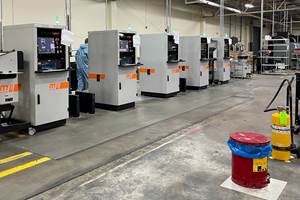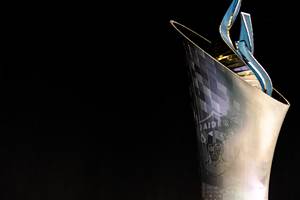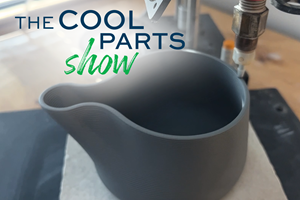7 Things You’ll Learn at the NPE2024 3D Printing Workshop
Are you a molder, toolmaker or OEM looking to adopt 3D printing? Here are 7 lessons about this technology that will be explored during a workshop at NPE2024: The Plastics Show.
Share
3D printing describes at least seven distinct types of manufacturing technologies that build parts through layering material. While 3D printing was once confined to the realm of rapid prototyping, today the technology is being applied within the plastics industry for everything from metal and ceramic 3D printing to deliver mold tooling to direct 3D printing of thermoplastics and thermosets to produce end-use parts.
At NPE2024: The Plastics Show, Additive Manufacturing Media is hosting the 3D Printing Workshop, a half-day event focused on the various ways this technology is reducing lead times, saving money and enabling new possibilities in the plastics industry. Join us on the afternoon of May 8, 2024, to hear directly from contract manufacturers, molders, toolmakers, OEMs and technology suppliers who are applying 3D printing successfully today.
You’ll learn how to…
1. Identify Additive Manufacturing Opportunities
Not every polymer part is a perfect fit for 3D printing, and most will require some amount of redesign to make this production technique reliable and cost-effective. The decision to 3D print should also take into account material properties, postprocessing needs and any qualification requirements that the parts will need to meet.
Workshop speaker: Daniel Baker from contract manufacturer Endeavor 3D will share how the company processes 3D printed parts from the initial identification of designs suitable for the process all the way through production and part qualification.
2. Choose Between 3D Printing and Injection Molding
Beyond considerations of material, cost and volume in production, the choice of manufacturing method affects the entire journey of a product’s lifecycle from initial concept to end-of-life repair and replacement. OEMs and designers should consider multiple options to ensure the best solution, which could be 3D printing, conventional injection molding or even be a hybrid method that combines elements of both.
Workshop speaker: Greg Paulsen from digital manufacturing platform Xometry will speak to the factors to consider when deciding between direct plastic 3D printing and a more conventional injection molding process.
3. Cut Lead Time on Product Development
3D printing can be applied for rapid prototyping to quickly arrive at a final part design, but it doesn’t need to deliver the parts directly in order to help speed product development. Applying the process to quickly produce mold tooling can bring significant time savings as well. Mold inserts can be 3D printed from polymers and composites for many short-run and prototype applications, while metal 3D printing supports more durable tools that can be used from product development into production.
Workshop speaker: Michael Belmont from moldmaker and molder Westminster Tool will share how the company applied metal 3D printing to produce an H-13 equivalent prototype tool and mold production-representative parts for a medical application on an accelerated timeline.
4. Automate Toolmaking
3D printing can also be a boon to toolrooms facing a skills shortage or seeking to increase productivity. A 3D printer can run largely unattended as it prints a mold insert, and one operator can typically oversee multiple machines. This more autonomous production process can enable companies to produce mold tooling more quickly, and enable skilled toolmakers to devote more of their time to designing solutions for complex problems.
Workshop speaker: Ted Sorom of Mantle will describe the company’s metal 3D printing process specifically developed for mold tooling and share examples of how injection molders, OEMs and toolshops are using this technique.
5. Qualify 3D Printed Parts
Qualification of parts in regulated industries is a key consideration before choosing additive manufacturing for production. Design allowables and other factors may be different for 3D printed polymer parts versus their molded counterparts, and standards may not always be readily available. That said, qualified polymer 3D printed parts are already being used in industries including automotive, medical and aerospace.
Workshop speakers: Si Chen and Javed Mapkar from Eaton will share how the company has qualified B-basis allowables for the fused granular deposition process and is producing aerospace structures from a conducting nanocomposite-based PEKK.
6. Solve Supply Chain Gaps
3D printing may not be the final production choice, but it can be a valuable tool for manufacturing early runs of parts and products, and to deliver parts in the event of a supply chain disruption. In these cases, the technology is used to “bridge” production between moments where conventional manufacturing technologies cannot meet the need. Applying 3D printing this way enables startups and inventors to put products into the marketplace before investing in mold tooling, enables molders to deliver early orders while the tooling is made, and helps OEMs meet demand for polymer parts if tooling or other supplies are inaccessible.
Workshop speaker: Andrew Roderick from Extol will discuss the value of using additive manufacturing for bridge production and how to develop and launch successful applications.
7. Apply 3D Printing for Mass Production
While additive manufacturing excels in many low-volume applications, the technology has advanced to the point that it is now suitable for many mass production scenarios as well. The costs of 3D printers and materials are coming down, while at the same time the technology is becoming more reliable and faster. For the right application, 3D printing can now deliver part quantities in the hundreds of thousands and above.
Workshop speaker: Spencer Loveless of Merit3D will share how his company successfully delivered an order of more than 1 million 3D printed pieces of a single part.
Related Content
Additive Manufacturing Production at Scale Reveals the Technology's Next Challenges: AM Radio #28
Seemingly small issues in 3D printing are becoming larger problems that need solutions as manufacturers advance into ongoing production and higher quantities with AM. Stephanie Hendrixson and Peter Zelinski discuss 6 of these challenges on AM Radio.
Read MoreThe World’s Tallest Freestanding 3D Printed Structure
Dimensional Innovations paired additive and subtractive manufacturing to create a monument for the NFL’s Las Vegas Raiders new stadium. The “never been done before” project resulted in the world’s tallest freestanding 3D printed structure.
Read More3D Printed Ceramic Mug: The Cool Parts Show #48
MadeXBinary applies additive manufacturing to clay. The company achieves automated production of aesthetically pleasing kitchenware through digital pottery.
Read More8 Cool Parts From RAPID+TCT 2022: The Cool Parts Show #46
AM parts for applications from automotive to aircraft to furniture, in materials including ceramic, foam, metal and copper-coated polymer.
Read MoreRead Next
8 Ways the Plastics Industry Is Using 3D Printing
Plastics processors are finding applications for 3D printing around the plant and across the supply chain. Here are 8 examples.
Read MoreAM Workshops: The 3D Printing Conferences at NPE and IMTS 2024
We are presenting half-day conferences on additive manufacturing at both of the two largest manufacturing events in North America this year. Join us!
Read More3D Printing Brings Sustainability, Accessibility to Glass Manufacturing
Australian startup Maple Glass Printing has developed a process for extruding glass into artwork, lab implements and architectural elements. Along the way, the company has also found more efficient ways of recycling this material.
Read More
.jpg;width=70;height=70;mode=crop)












